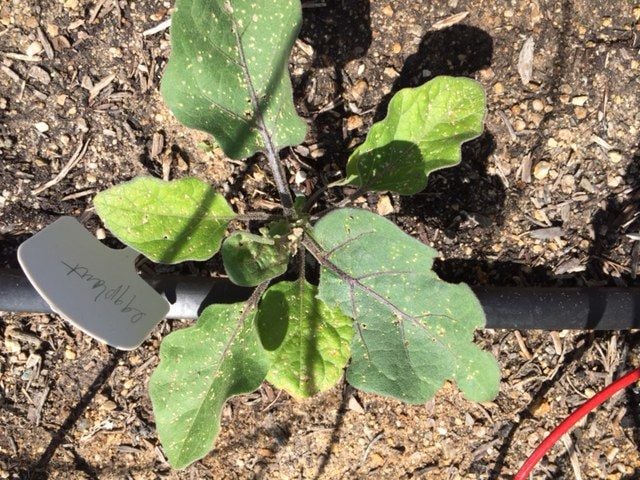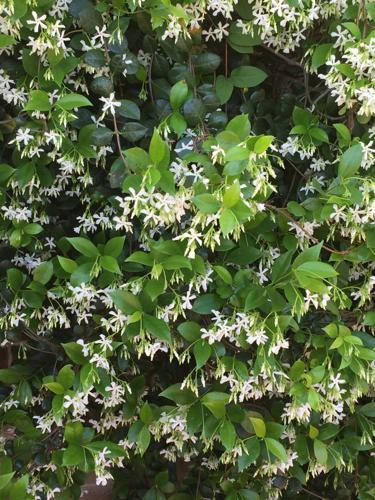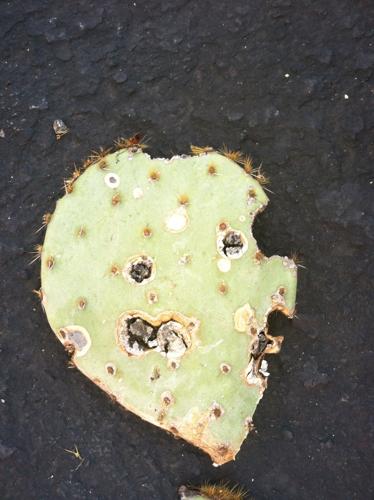Q: I live in Barrio Santa Rosa and have two massive Aleppos that were planted on my property in the early 1950s. I have noticed recently that many of the lower branches on one of the trees are dying. I am seeing brown needles throughout the tree, but not a lot. These trees have defined our property and it looks like they may have fallen victim to the bark beetle. One of the trees looks fine; the other I can see a dozen of the lowest limbs dead. This one has brown leaves sporadically throughout, but mostly at the bottom, not at the crown.
I have had the entire property on drip for 15 years or more, so I always considered them adequately watered. Also, the gutters from the roof drain into this part of the yard. Any advice you can give me would be greatly appreciated. What I’d really like to hear you say is that they just need a bit more water!
A: Your trees don’t appear to be infested with bark beetles from the photos. The holes look like woodpecker damage and the dead branches in the crown of the tree are normal as the trees age. It would be good to hire an arborist to climb the trees and cut out the dead and damaged branches both to clean it up and also to prevent dead limbs from falling and hurting you or damaging your property. Watering these large trees is difficult because the root zones extend two to three times the height of the tree. You are likely not getting water to the absorbing roots at the end by using a hose. The best you can do is drip irrigation with emitters arranged in a circular fashion outside the drip line of the tree. The schedule for watering should be every seven to 14 days in the summer, every 10 to 21 days in the spring and summer, and every 14 to 21 days in the winter. The water should reach a depth of 24 to 36 inches each time and you can use a soil probe to determine how deep the water is going. So it’s not time to give up on your trees if you are willing and able to provide the water necessary to keep them in good health.
Q: One of my prickly pears became riddled with black splotches. The attached photo is of a typical pad but there are many pads at the bottom of my trash bin that were worse. I know about balances in nature and the benefits of coexistence, but this plant was an eyesore and had to go. I think the problem is caused by a fungus. I want to replace it with an Engelmann’s prickly pear. It also looks like a rodent chewed the outer edges of some of the pads. Can you ID the fungus if it is a fungus? How persistent is it in the soil? If it is persistent can I treat the soil with a fungicide so the new prickly pear doesn’t get the fungus? Is the chewing damage more likely to have been done by a packrat or a Harris’ rock squirrel (we have both)?
A: Several pests or conditions may cause lesions on prickly pear but the most common is known as Phyllosticta pad spot and it is persistent in our area. I am afraid that no amount of fungicide would take care of this since it is endemic to the desert and very common. It spreads by releasing spores that are transported by rain and wind, and is difficult to manage. Severely infected pads or plants should be removed from your landscape as you are already doing. That’s about all you can do. The chewing damage could have been done by any of the resident rodents or javelinas if you have them as well.
Q: Thanks for the bug lesson last weekend at the Jewish Community Center. Thanks to you, I was able to identify lace bugs on our sunflowers (you predicted they would show up) and I mitigated with blue Dawn. While there, I noticed that our Japanese eggplant have something going on with them. No insects were visible.
A: Flea beetles are eating your eggplant leaves. They are tiny and hard to see, and they tend to jump like fleas when they sense danger. They are one of the most difficult-to-manage pests of eggplant and cole crops. They are also a problem on seedlings of tomatoes, potatoes, peppers, turnips, radishes and corn. There are various species of flea beetles, all members of the Chrysomelidae family. The adults are active leaf-feeders that can, in large numbers, rapidly defoliate and kill plants. You are seeing the symptoms of adult flea beetle feeding: small, rounded, irregular holes that make leaves look as if they had been peppered with fine shot. Additional damage may be done by the larvae, which feed on plant roots. Some flea beetles are considered general feeders, though many species attack only one plant or closely related kinds of plants. Because of this you can sometimes use anther crop to lure them away. For example, radishes are sometimes preferred over eggplant. Another tactic is to put yellow sticky traps near your plants to attract and capture these insects. Organic products that have some effectiveness are insecticidal soap and neem oil. Pyrethrin products such as Pyganic as well as hot pepper wax and rotenone are reported to be better.
No matter what you choose, the most important things to do are spray them early in the season before they do too much damage to young plants and read the label before you use these products so you are aware of safety precautions for using them.
Q: We just installed five viga posts on our back patio. Two of them are where I could plant a vine in the ground; the other three need to be in a pot. Height to the patio roof is about 11 feet. Looking for something I can train to grow up and around the post, but the kind that cling. The area gets morning sun until about 11:30 a.m. and then shade the rest of the day. Flowering, thornless and non-deciduous would be ideal. Would also like to find a vine that I might be able to use along our retaining wall, specifically in the sections that have an iron railing between the stucco posts. This would be full sun most of the day and the height of the iron fence is about 6 feet.
Answer: My first thought is star jasmine because I have it growing at my house and it’s flowering now. It does well in part shade and produces very fragrant flowers in the spring. For the retaining wall, you might consider cat’s claw. This vine loves full sun and will cover a sturdy wall. These are fast growing and need to be managed but most vines are that way to some extent. There are other vines to choose from; search for options at az1606.pdf






